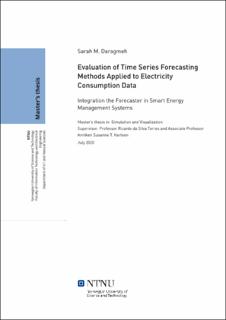| dc.description.abstract | Background: Electric energy is one of the most value that economic growth in the modern world depends on, particularly in societies, industries and economies that depend entirely on the use electric energy. Therefore, finding cheap, clean, and continuous energy sources to meet the increasing demand is very important. The demand of energy is increasing constantly, and it is expected to increase by 50 percent by 2050. Electric load
forecasting is an important tool which has been used to ensure that power utilities meet the consumers’ need. The use of advanced technology, such as Advanced Meter System (AMS) and Internet of Things (IoT), provides the power utilities with a huge amount of data which can be used to design and implement intelligent energy management systems. The proper use of electricity consumption data better services and opportunities to engage consumers in demand response. Time series forecasting is the core of smart energy management systems. Good forecasting in turn accuracy helps in building robust systems.
Objectives: The main objective of this study is to build a time series forecasting model which performs best on the electricity consumption data, and propose methods to integrate the forecasting model in smart energy management systems. Energy management systems are important to maintain energy sustainability in heterogeneous energy systems.
Methods: Statistical analysis was performed to understand the electricity consumption data of consumers from Aalesund, and to find the time series components. Different methods were applied to the time series of the total electricity consumption in the purpose of forecasting (short-term and mid-term). The methods are divided classical statistical methods for time series forecasting (such as; auto regressive integrated moving average (ARIMA) and exponential smoothing (ES)), and machine learning methods (such as; linear regression, recurrent neural network (RNN), long short term memory (LSTM), convolution neural network (CNN), support vector machine (SVM), and K-nearest neighbor (K-NN)). A comparison study of the models’ performance was done to find the best model. Also, there are two cases where we proposed conceptual models to integrate the forecasting model in energy management systems.
Results: Data analysis showed that the electricity consumption data has trend, seasonality, and noise. The evaluation of different statistical and machine learning methods indicates that machine learning models performed generally better than statistical methods on the given data. Statistical methods required much involvement from the user during the experiments, but this did not help in achieving best performance. Among the statistical methods, seasonal auto regressive integrated moving average (SARIMA) achieved the best performance for both short-term and mid-term load forecasting. CNN wavenet outperforms all the tried
methods (i.e., statistical and machine learning methods) in both short-term and mid-term load forecasting. The simulation results from the proposed model of an intelligent energy management system showed the importance of load forecasting in such smart systems. The results showed how the energy in micro-grid systems can be managed efficiently depending on the forecasting values. Also, the simulation results form the scheduling of shiftable appliances case, showed that the consumer can save up to 300 NOK monthly by using shiftable appliances on optimal times.
Conclusion: Load forecasting is an important topic for different smart solutions such as smart micro-grids, and smart, green and sustainable cities. This work provides a methodology to design a good time series load forecasting model which depends on the available data, and show the effectiveness in applying the forecasting model in different domains. Also, we conclude that the machine learning methods outperform statistical methods, and CNN wavenet performed best on our data. | |
